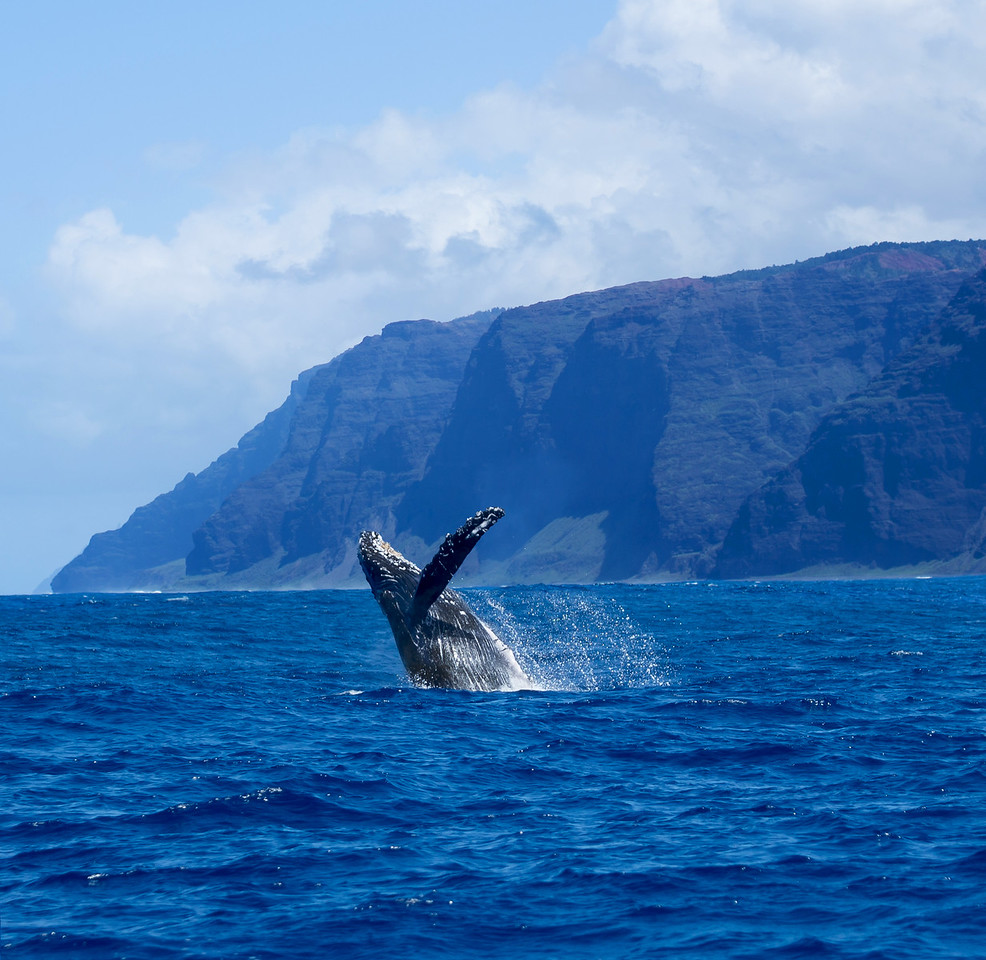Humpback Whale Conservation

HUMPBACK WHALE CONSERVATION AND THE HYDROPHONE
It’s the end of fall which means we’re right around the corner from humpback whale season here in Hawaii! Soon our Holo Holo Charters Captains, crew, and guests will be oohing and ahhhing daily during our Kauai, Napali Coast, and Niihau boat tours– as massive, intelligent, sentient, and curious humpback whales seem to show off with their breaching, waving, and spy-hopping.
The acrobatic and spectacular behavior of humpback whales is a sight to behold and one that, thanks to conservation efforts in the 1970s, we’re able to witness today.
In this blog post, we’ll describe a bit about our local humpback whale population and discuss the connections between humpback whale songs, whale conservation, and a technology called the hydrophone. We’ll also describe how we’re sometimes able to use hydrophones to listen to whale songs live, during our boat tours!
North Pacific Humpback Whales
 A group of an estimated 21,000 whales1, designated as the North Pacific humpback whales, split their time between Alaska and Hawaii, migrating back and forth for their annual feeding and breeding cycles.
A group of an estimated 21,000 whales1, designated as the North Pacific humpback whales, split their time between Alaska and Hawaii, migrating back and forth for their annual feeding and breeding cycles.
Hawaii and Alaska? Not a bad system!
These powerful and majestic creatures spend the long summer days up north, employing their signature “bubble-netting” hunting technique, gulping up krill and small fish, and straining huge volumes of ocean water through their baleen plates. They’re putting on weight.
Come fall, it’s time to leave the sub-arctic Alaskan waters and swim south for about 3,000 miles, practically non-stop for 6 to 8 weeks, before reaching their sub-tropical winter home in Hawaii– where they mate, give birth, nurture their calves, and sing their songs.
Beginning in October, mother whales nursing their calves are usually the first to arrive in Hawaii. Then juveniles and mothers with their yearlings come, teaching them the migration, and often weaning them here in Hawaiian waters. The adult males come next and finally, the pregnant females arrive, after feeding up to the last minute in Alaska.
Impressively, the North Pacific humpback annual migration of some 6,000+ roundtrip miles is one of the longest of any mammal on Earth.
The North Pacific humpback whales are a conservation success story! Over the last few decades, the population, once decimated by human exploitation, has grown ten-fold– from a low of approximately 2,000 whales to the estimated 21,000 whales today.
The waters surrounding the Hawaiian Islands are one of the most important humpback whale habitats and while humpbacks are no longer listed as an endangered species in Hawaiian waters, they are still protected by federal and state regulations.
Whale conservation dates back to the early 1970s and is rooted in a technology called the hydrophone.
Hydrophones
A hydrophone (Ancient Greek ’water + sound’) is a microphone designed to be used underwater for recording or listening to underwater sound. The first hydrophones were developed during WW1 to help submarine crews avoid collision with icebergs.
In the late 1960s, biologist and conservationist Dr. Roger Payne discovered whale song by observing– with a hydrophone– that humpback whales emit sounds in long, predictable patterns, ranging over frequencies audible to humans. He published an article in Science titled Songs of Humpback Whales and crucially, released a self-produced album titled Songs of the Humpback Whale. The 1970 album publicly demonstrated for the first time the elaborate vocalizations of humpback whales and ended up selling over 100,000 copies, becoming the most popular nature recording in history.
People started seeing (hearing?) whales in a whole new light! By raising awareness of the intelligence and social culture of whales, Roger Payne’s research, and especially the album helped spawn the worldwide “Save the Whales” movement which in turn led to the 1972 United Nations Conference on the Human Environment ten-year global moratorium on commercial whaling, which was observed by all but a few nations.
Thanks to Roger Payne’s keen ear, creativity, and passion for whales, we’re able to listen to humpback whale songs with our own ears!
Hydrophones on Holo Holo Tours
We carry hydrophones aboard our Kauai tour boats, and occasionally, nature affords us the proper combination of ocean conditions to use them!
According to Holo Holo Captain and Systems Operation Manager Jessica Rickard, we must be experiencing minimal movement from wind, current, or waves. The boat must be turned off, and no other vessels can be in the immediate area.
If such conditions can be found, we simply drop the “microphone” end of the hydrophone into the water, plug the other end into a speaker, stop talking, and listen to the magic.
Captain Jess explained that while what we are listening to is not fully understood, there are some things that are known:
- All whales make sounds but only the males sing the highly organized whale songs.
- They sing the song all the way through, pausing to breathe as needed, and then start over!
- All the male whales in one population, the North Pacific humpbacks for example, sing the same song.
- However, they’re not synchronized so the cacophony heard through a hydrophone is all the males, within a few miles of ocean, singing various parts of the song.
- The song will be modified as the season goes on, though it is not understood what whale makes the changes or how they manage to all get the memo. At the start of a new breeding season, the song picks up where it left off the last breeding season. It is a continuously evolving piece of music!
- They have been known to start singing in Alaska or during the migration, but they do most of their singing here in the Hawaiian breeding grounds. So, most likely it is a behavior that plays a role in breeding.
- When they are singing, males tend to be hanging motionless 40-50ft below the surface with their head pointed down and their tails pointed up. The whales you see on the surface while listening to a hydrophone are not the whales you are actually hearing.
You’re probably thinking, “Ooooh how cute is that? It’s a love song,” but Captain Jess tells us we can probably scratch that idea– studies suggest that the females are not even the ones listening to the song! Some hypothesize that the songs are a tool the males use to organize themselves and their breeding strategies. But again, whale songs are still mysterious…
Whale Season For Kauai Boat Tours

Our company was founded in 1997 and in our 25 years, we’ve definitely witnessed first-hand the great humpback comeback. Today’s estimated North Pacific humpback whale population of 21,000 actually exceeds recovery goals.
Which is… great! The more whales, the more our guests are able to witness the sheer size, playful behavior, and occasionally even the whale songs exhibited by these awe-inspiring animals. We believe that the more people are exposed to the mystifying wonder of the natural world, the more inspired and motivated they are to protect it. After all, look at what Roger Payne’s album did for whale conservation!
However, as more humans and whales are sharing space, extra precautions must be taken during whale season to avoid collisions and habitat disturbance.
Holo Holo Charters takes a do-no-harm approach to all ocean wildlife and strictly follows all NOAA guidelines and federal laws for approach limits. We stay 100 yards away, don’t surround whales with boats, or cut off their direction of travel.
Our Captains and crew keep a watchful eye out for any whales (also sea turtles, monk seals, and dolphins) that appear to be injured or in poor health and report all relevant sightings to the NOAA/DLNR Hawaii Statewide Marine Animal Stranding, Entanglement, and Reporting Hotline.
We’re grateful for the work of Dr. Roger Payne and for the foresight of the original whale activists. Without the protections they fought for, chances seem slim we’d be writing about the North Pacific whale population today, let alone going out all winter long to observe it with our own eyes.
We invite you to join us on any of our four Napali Coast boat tours, Kauai boat tours, and Niihau boat tours this humpback whale season, November-April. All the sightseeing, snorkeling, sailing, wining, and dining as usual with a darn good chance of seeing (and possibly hearing!) some magnificent North Pacific humpbacks too!
We generally send newsletters about once a month
